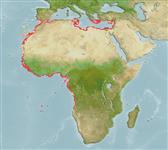Environment: milieu / climate zone / depth range / distribution range
Ecology
Marine; demersal; depth range 90 - 220 m (Ref. 5222). Subtropical; 37°N - 16°S, 19°W - 37°E (Ref. 5222)
Eastern Atlantic: Mediterranean to southern Angola.
Size / Weight / Age
Maturity: Lm ? range ? - ? cm
Max length : 125 cm TL male/unsexed; (Ref. 111103); max. published weight: 25.0 kg (Ref. 5222)
Dorsal spines (total): 11; Dorsal soft rays (total): 14 - 15; Anal spines: 3; Anal soft rays: 9. Distinguished by the following characteristics: dark brown head and body color; soft dorsal, caudal and anal fins blackish distally, basal part lighter; white edge on caudal and pectoral fins; blackish pelvic fins; black streak on cheek at the upper edge of maxilla; depth of body contained 2.4-2.8 times in SL; head length 2.2-2.4 times in SL; convex interorbital area; subangular preopercle, with enlarged serrae at the angle, lower edge with 1-6 small serrae; posterior nostrils 2-3 times larger than anterior nostrils; maxilla naked, not reaching posterior to eye; 2 rows of teeth on midlateral part of lower jaw, inner teeth distinctly larger than outer teeth (Ref. 89707).
Body shape (shape guide): fusiform / normal; Cross section: compressed.
Deep-water species. Occurs on mud, sand, or rocky bottoms (Ref. 89707).
Life cycle and mating behavior
Maturity | Reproduction | Spawning | Eggs | Fecundity | Larvae
Heemstra, P.C. and J.E. Randall, 1993. FAO Species Catalogue. Vol. 16. Groupers of the world (family Serranidae, subfamily Epinephelinae). An annotated and illustrated catalogue of the grouper, rockcod, hind, coral grouper and lyretail species known to date. Rome: FAO. FAO Fish. Synop. 125(16):382 p. (Ref. 5222)
IUCN Red List Status (Ref. 130435: Version 2025-1)
Threat to humans
Harmless
Human uses
Fisheries: minor commercial
Tools
Special reports
Download XML
Internet sources
Estimates based on models
Preferred temperature (Ref.
123201): 14.2 - 17.1, mean 15.6 °C (based on 37 cells).
Phylogenetic diversity index (Ref.
82804): PD
50 = 0.5000 [Uniqueness, from 0.5 = low to 2.0 = high].
Bayesian length-weight: a=0.01148 (0.00662 - 0.01991), b=3.05 (2.91 - 3.19), in cm total length, based on LWR estimates for this species & Genus-body shape (Ref.
93245).
Trophic level (Ref.
69278): 4.0 ±0.7 se; based on size and trophs of closest relatives
Resilience (Ref.
120179): Very Low, minimum population doubling time more than 14 years (Preliminary K or Fecundity.).
Fishing Vulnerability (Ref.
59153): High to very high vulnerability (75 of 100).
🛈
